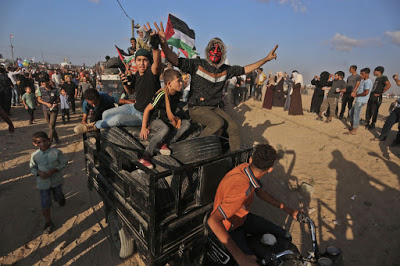Seven more are killed at Gaza fence as old man urges, ‘Sons, do not waste your life living in siege’
 |
| Ahmad Kabariti – October 13, 2018 |
Seven Palestinians were added today to the 199 killed during protests at the Gaza-Israel border throughout 29 successive weeks of the Great March of Return since the protests began March 30.
Another 250 were injured on Friday’s protest by the Israeli forces’ live fire, including one critically injured and five seriously wounded, the Gaza health ministry reported. Some 15,000 Palestinians were protesting at the border.
The soldiers killed five men east of Al-Bureij refugee camp. Young demonstrators were able to retrieve the bodies and they were transferred to Al-Aqsa Martyrs Hospital. The sixth was killed east of Rafah in the southern enclave, while the seventh was killed in the “Malaka” area east of Gaza City. Local sources said.

Protests at the Gaza fence, Oct. 12, 2018, photo by Mohammed Asad.
The seven victims identified so far are Ahmed Ibrahim Zaki al-Taweel (27), Mohammed Abdulhafiz Ismail (29), Ahmed Abu Naeem (17), Abdallah al-Daghma (25) Afifi Mahmoud Afifi (18) Tamer Abu Ermana (22) and Mohammed Abbas (21).
Through the thick black smoke of burning tires, the crowds that gathered at the eastern border of the Strip could see scores of young men dragging wire fencing away from the Israeli border.

Protests at the Gaza fence, Oct. 12, 2018, photo by Mohammed Asad.
Many of the protesters wore gas masks made out of soda cans and pieces of cloth, as tear gas rained down periodically.
At the scene, ambulances roared through the fields gathering the wounded. When there were not enough vehicles, demonstrators lifted wounded people in their arms or onto gurneys to move them out of the impasse.

Protests at the Gaza fence, Oct. 12, 2018, photo by Mohammed Asad.
Walking slowly with a cane along the Malaka fence, Suliman Abu Arar, 80, was urging the young protesters to move forward to the barbed wire. He said: “Go ahead sons, run closer to the wire.. seventy years being refugees are enough…Do not waste your youth life living in siege.”

Protests at the Gaza fence, Oct. 12, 2018, photo by Mohammed Asad.
Ali Masoud, 27, who was wounded in both legs earlier in June, says that what is happening is a really like a “hell day”. “I don’t know which way to run away from the bullets buzzing everywhere. We are living in hell in central Gaza, and here their bullets are chasing us beside the border like hunting ducks in a closed lake,” Masoud told Mondoweiss.

Protests at the Gaza fence, Oct. 12, 2018, photo by Mohammed Asad.
Since March, protesters have orchestrated near-weekly protests along the fence, pressing to lift a stifling Israel siege imposed 11 years ago.
Today’s protest ended by sunset, and Israel’s Defense Minister Avigdor Lieberman announced he had instructed that fuel deliveries to Gaza through Israel be halted because of violence at the border. Lieberman said that “Israeli will not tolerate a situation in which fuel tankers are allowed to enter Gaza on the one hand, while terror and violence are used against IDF soldiers and Israeli citizens on the other.”

Protests at the Gaza fence, Oct. 12, 2018, photo by Mohammed Asad.
Hamas’ chief, Ismail Haniyeh, said, “The determination of the Palestinian people will break the siege.”
Earlier Friday, Lebanese newspaper Al Akhbar reported that Hamas had received a letter from the UN’s deputy envoy to the Middle East James McGoldrick, which includes terms to ease conditions in the Gaza Strip in order to prevent further tensions.

Protests at the Gaza fence, Oct. 12, 2018, photo by Mohammed Asad.
According to the report, Israel demands the freezing of the weekly Palestinian protests, known as the March of Return, which started in March, as well as ending all attempts to cross the border, launch incendiary balloons and kites, and return to the cease-fire conditions of the summer of 2014.
At the same time, Hamas demands a 50-megawatt increase in the supply of electricity to Gaza and a solution to the enclave’s electricity service problems. Other demands include expanding the fishing zone to 12 miles from the coast, and then to 20 miles as was agreed to in the 1990s; unlimited entry of goods to Gaza; exports of goods; and Israeli work permits for 5,000 Gazans.

Protests at the Gaza fence, Oct. 12, 2018, photo by Mohammed Asad.
The protesters are demanding an end to an Israeli and Egyptian blockade on the narrow coastal strip, which is home to around 2 million Gazans.
They also seek the right to return to lands that Palestinians fled or were driven from upon Israel’s founding in 1948.
By the nightfall, the old man who was staring at the almost deserted protest location told Mondoweiss that “One dreary day has been added on Gaza’s thousands of such days”.

Protests at the Gaza fence, Oct. 12, 2018, photo by Mohammed Asad.


